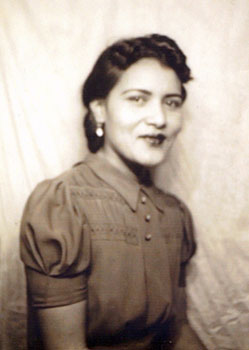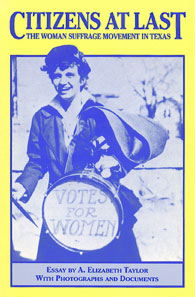
The link between women and Texas history is as old as the place itself. The first known history of Texas written in English was by a woman, Mary Austin Holley, and was published in 1836. By 1888, Anna Pennybacker's history of the state had become a standard text for turn-of-the-century students. The study of women in Texas, however, has a much more modern lineage. Annie Doom Pickrell's 1919 book, Pioneer Women of Texas, was one of the earliest attempts to record women's experiences. Scholars conducted research about women in Texas as early as the 1930s, and in 1936 the nation's oldest and largest resource collection about women, "the Woman's Collection" was created at Texas Woman's University (TWU). Jacquelyn Dowd Hall's groundbreaking 1979 book, Revolt Against Chivalry: Jessie Daniel Ames and the Women's Campaign Against Lynching, illuminated the intersections of race, class, and gender in the reform efforts of a Texas woman. Not until the 1980s, however, was there a statewide surge of interest in the history of women in Texas.
In 1980, the Texas Women's History Project Bibliography, a description of primary and secondary sources about women in Texas was published by the Texas Women's History Project of the Texas Foundation for Women's Resources (now Women's Resources, WR), with assistance from the Texas Committee for the Humanities (TCH), among others. In 1981, using the resources uncovered in the bibliography, the Texas Women's History Project, with assistance from the TCH, the RGK Foundation and others, produced a project unique not only in Texas but nationwide: "Texas Women: A Celebration of History," an exhibit recognizing the state's famous and unsung women. The exhibit traveled throughout the state to wide acclaim and is now housed at TWU. An archive about Texas women, another result of this large undertaking, now exists as part of TWU's Woman's Collection. Among those who made the exhibit possible were Ruthe Winegarten, Janelle Dupont, Mary Beth Rogers, Sherry Smith, Melissa Hield, Frieda Werden, and Mary Sanger.
In 1984, Julia Kirk Blackwelder's Women of the Depression: Caste and Culture in San Antonio, 1929-1939 appeared. The same year, a three-year research assistantship in women's history for the mammoth New Handbook of Texas revision project was undertaken by the Texas State Historical Association (TSHA), funded by TWU, WR, and the Temple family (through the Katherine Sage Temple Fellowship). This enabled the association to conduct much-needed research into the lives of women for the Handbook, which is the standard reference work in Texas history. The Handbook revision, lasting through 1996, provided a fertile ground for original research by young historians, many of them graduate students and new Ph.D.s. Judith McArthur, Nancy Baker Jones, Debbie Mauldin Cottrell, Teresa Palomo Acosta, Cynthia Orozco, Angela Shelf Medearis, and Sherilyn Brandenstein were among those who contributed to the revision and would later publish their own work. Ruthe Winegarten was a long-time volunteer contributor and advisor about women's history to the Handbook's research staff.
A 1985 conference, "Women and Texas," helped identify and discuss topics about women that should be covered in the revised Handbook. The conference was co-sponsored by TSHA, with TCH, WR, and the Women's Studies Program and the Center for Studies in Texas History at The University of Texas at Austin. The same year, Texas A&M University Press published Texas Tears and Texas Sunshine: Voices of Frontier Women edited by Jo Ella Powell Exley, a text still used in university classes. In 1987, in response to Congressional designation of March as National Women's History Month, the Texas Historical Commission (THC) began to coordinate the celebration of the event throughout the state.
In addition to these developments, the 1980s witnessed the emergence of a growing number of graduate students and new Ph.D.s in Texas women's history, and the consequent publication of more scholarly articles, monographs, and books than had previously been possible – enough, for example, to warrant a revision of the Texas Women's History Project Bibliography by Texas Woman's University. Interest in women's history had grown so significantly, in fact, that by 1986 Texas historian Fane Downs could write that the study of the history of women had evolved from the "historiographical stage of 'oh look!'… which catalogued women and affirmed their presence, to works of synthesis and interpretation, which are attempting to describe the larger issues in women's history."

In 1987, Ellen C. Temple, Press published Citizens at Last: The Woman Suffrage Movement in Texas, a groundbreaking compilation of essays, documents, and photographs edited by Ruthe Winegarten and Judith N. McArthur. In 1988, Temple Press published A Texas Suffragist: Diaries and Writings of Jane Y. McCallum by Janet G. Humphrey. In addition, Lewis L. Gould published Lady Bird Johnson and the Environment (University Press of Kansas), a detailed account of the First Lady's impact on environmentalism.
Two notable publications in 1989 were Women in Texas History: They Made a Difference by Cynthia J.Beeman –a compilation of articles and photographs Beeman had published in celebration of Women's History Month in the Austin American-Statesman the previous year—and historian Paula Mitchell Marks's dual biography, Turn Your Eyes Toward Texas: Pioneers Sam and Mary Maverick, published by Texas A&M University Press.
In 1990, a number of statewide organizations and associations sponsored the statewide conference, "Women and Texas History," in Austin. One direct result of this conference was the creation of the Texas Women's History Network in 1991, which held annual meetings and conferences to foster research and writing in Texas women's history. A compilation of essays presented at the conference, Women and Texas History: Selected Essays (edited by Fane Downs and Nancy Baker Jones) was published by TSHA in 1993. The same year, Debbie Mauldin Cottrell published the first full length biography of Annie Webb Blanton, Pioneer Woman Educator (Texas A&M University Press).
The University of Texas at San Antonio created the Center for the Study of Women and Gender (CSWG) in 1994, which, under the leadership of Linda Schott, formed its own Archive for the Study of Women and Gender to focus on Texas women's history. In conjunction with the centennial celebration of the first female to have served in a state legislature, Schott and the CSWG collaborated with State Representative Sylvia Romo and Texas historians Ruthe Winegarten and Nancy Baker Jones to produce Texas's video contribution to the national celebration. The result was Getting Where We've Got to Be: The Story of Women in the Texas Legislature, completed in 1996.
Also in 1996, the New Handbook of Texas History was published in six volumes by TSHA and was later made available online. The Handbook includes many biographical sketches and articles about women. In 1997, the WR published a video history for 7th graders, True Tales of Texas Women, which was distributed free of charge to all Texas school districts. Winegarten and Jones collaborated on that project.
The turn of the century was particularly productive. In 1997, two notable publications appeared: Texas, Her Texas: The Life and Times of Frances Goff, by Nancy Beck Young and Lewis L. Gould, and Elizabeth Hayes Turner's Women, Culture and Community: Religion and Reform in Galveston, 1880-1920. The following year saw the release of Pauline Periwinkle and Progressive Reform in Dallas by Jacquelyn Masur McElhaney, Elizabeth York Enstam's Women and the Creation of Urban Life: Dallas, Texas 1843-1920, and Judith McArthur's Creating the New Woman: The Rise of Southern Women's Progressive Culture in Texas, 1893-1918. In 1999, Rebecca Sharpless's Fertile Ground/Narrow Choices: Women of Texas Cotton Farms, 1900-1940 appeared. In 2000, the first history of women in the Texas Legislature, Capitol Women: Texas Female Legislators, 1923-1999, by Winegarten and Jones, came out, and was offered with their video history, Getting Where We've Got to Be. In 2001, Angela Boswell's Her Act and Deed: Women's Lives in a Rural Southern County, 1837-1873 was published, and 2003 saw the publication of the groundbreaking compendium, Las Tejanas: 300 Years of History, by Teresa Palomo Acosta and Ruthe Winegarten, the long-awaited scholarly biography, Minnie Fisher Cunningham: A Suffragist's Life in Politics, by Judith N. McArthur and Harold L. Smith, and Julia Blackwelder's Styling Jim Crow: African American Beauty Training During Segregation.
While much as been achieved in recent decades, much work is still left to be done. Just as one example, more than a decade has passed since the New Handbook of Texas was published, and research about women for future inclusion has not kept up in the interim. From our seats in the new 21st Century, while historians can look back to decades of progress, we can also look forward to accomplishments that await us and to writing many stories as yet untold.
For a more complete accounting of this history, please see Nancy Baker Jones, “Making Texas Our Texas: The Emergence of Texas Women’s History, 1976-1990.” Southwestern Historical Quarterly (January, 2017).